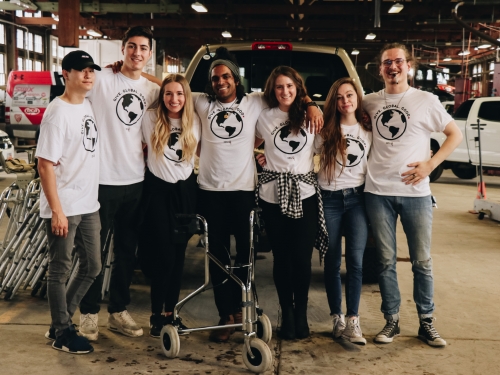Innovation is not always about complex or completely new ideas. A simple process, adapted from another geographical location or sector, can make a large impact.
Think of the last time you, or someone you know, owned a pair of crutches, canes, a walker, or even a wheelchair. We use these various medical devices for a short amount of time, then what?
Project Embrace enables these devices to be reused by patients who need them most. Due to the unique, yet simple nature of their approach, Project Embrace was a Social Investors Forum finalist and won the Fall 2019 Audience Choice Award.
When Project Embrace founder, Mohan Sudabattula, was volunteering at a local hospital making orthotics and prosthetics for children, he learned that custom medical devices, which take hours to make and can cost thousands of dollars, are often thrown away after only a few months of use. “I would be the one that physically walked them to the dumpster and threw them away, and that just did not feel right,” Mohan says. Standing by a dumpster with dozens of barely-used orthotics and prosthetics, Mohan had an idea: what if we could share our gently used medical devices with those who need them, but lack access?
Since orthotics and prosthetics must be uniquely created for individual patients, it’s nearly impossible to reuse them. However, more standard medical devices - crutches, braces, and wheelchairs, to name a few - can be easily transferred from patient to patient. Reusing medical devices is common in other developed countries, but in the United States, it is rare. Project Embrace saw this as an opportunity to rehouse gently used medical devices with high-need populations. “We took what was successful in the governments of other nations and created a nonprofit,” Mohan explains, “but in doing so are not bound by regulations in a complicated healthcare system and now can specifically help the most vulnerable populations around the world that the government doesn’t reach.”
Who is Project Embrace trying to reach? Any group who needs greater access to healthcare is on their radar, including indigenous tribes, refugees, undocumented patients, those that are impoverished, those experiencing homelessness, and prisoners.
Project Embrace’s model includes three key components: collecting, refurbishing, and re-distributing. Although donations are accepted at any time, about every three months, they host a “donation tour” to collect items. Project Embrace rents a large truck and picks up medical devices from individual Utahns, hospitals, and donation centers such as Deseret Industries. After collecting anywhere from 150 - 300 medical devices, Project Embrace hosts a refurbishing day, where volunteers inspect, catalog, and refurbish the items. About 92% of the medical devices are able to be restored and prepared for a new patient. Finally, medical devices are driven or shipped to partner organizations who have identified individuals in need - meaning that the refurbished items are delivered directly to new patients who need them most.
Support Project Embrace’s mission today by donating to pay for refurbishing medical devices ($100 will cover about 75 medical devices), donating your gently used medical device, or volunteering your time to restore medical devices.


